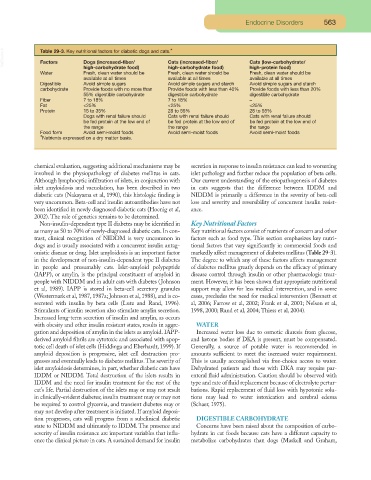Page 544 - Small Animal Clinical Nutrition 5th Edition
P. 544
Endocrine Disorders 563
VetBooks.ir Table 29-3. Key nutritional factors for diabetic dogs and cats.* Cats (low-carbohydrate/
Dogs (increased-fiber/
Cats (increased-fiber/
Factors
Water high-carbohydrate food) high-carbohydrate food) high-protein food)
Fresh, clean water should be
Fresh, clean water should be
Fresh, clean water should be
available at all times available at all times available at all times
Digestible Avoid simple sugars Avoid simple sugars and starch Avoid simple sugars and starch
carbohydrate Provide foods with no more than Provide foods with less than 40% Provide foods with less than 20%
55% digestible carbohydrate digestible carbohydrate digestible carbohydrate
Fiber 7 to 18% 7 to 18% –
Fat <25% <25% <25%
Protein 15 to 35% 28 to 55% 28 to 55%
Dogs with renal failure should Cats with renal failure should Cats with renal failure should
be fed protein at the low end of be fed protein at the low end of be fed protein at the low end of
the range the range the range
Food form Avoid semi-moist foods Avoid semi-moist foods Avoid semi-moist foods
*Nutrients expressed on a dry matter basis.
chemical evaluation, suggesting additional mechanisms may be secretion in response to insulin resistance can lead to worsening
involved in the physiopathology of diabetes mellitus in cats. islet pathology and further reduce the population of beta cells.
Although lymphocytic infiltration of islets, in conjunction with Our current understanding of the etiopathogenesis of diabetes
islet amyloidosis and vacuolation, has been described in two in cats suggests that the difference between IDDM and
diabetic cats (Nakayama et al, 1990), this histologic finding is NIDDM is primarily a difference in the severity of beta-cell
very uncommon. Beta-cell and insulin autoantibodies have not loss and severity and reversibility of concurrent insulin resist-
been identified in newly diagnosed diabetic cats (Hoenig et al, ance.
2002). The role of genetics remains to be determined.
Non-insulin-dependent type II diabetes may be identified in Key Nutritional Factors
as many as 50 to 70% of newly-diagnosed diabetic cats. In con- Key nutritional factors consist of nutrients of concern and other
trast, clinical recognition of NIDDM is very uncommon in factors such as food type. This section emphasizes key nutri-
dogs and is usually associated with a concurrent insulin antag- tional factors that vary significantly in commercial foods and
onistic disease or drug. Islet amyloidosis is an important factor markedly affect management of diabetes mellitus (Table 29-3).
in the development of non-insulin-dependent type II diabetes The degree to which any of these factors affects management
in people and presumably cats. Islet-amyloid polypeptide of diabetes mellitus greatly depends on the efficacy of primary
(IAPP), or amylin, is the principal constituent of amyloid in disease control through insulin or other pharmacologic treat-
people with NIDDM and in adult cats with diabetes (Johnson ment. However, it has been shown that appropriate nutritional
et al, 1989). IAPP is stored in beta-cell secretory granules support may allow for less medical intervention, and in some
(Westermark et al, 1987, 1987a; Johnson et al, 1988), and is co- cases, precludes the need for medical intervention (Bennett et
secreted with insulin by beta cells (Lutz and Rand, 1996). al, 2006; Farrow et al, 2002; Frank et al, 2001; Nelson et al,
Stimulants of insulin secretion also stimulate amylin secretion. 1998, 2000; Rand et al, 2004; Thiess et al, 2004).
Increased long-term secretion of insulin and amylin, as occurs
with obesity and other insulin resistant states, results in aggre- WATER
gation and deposition of amylin in the islets as amyloid. IAPP- Increased water loss due to osmotic diuresis from glucose,
derived amyloid fibrils are cytotoxic and associated with apop- and ketone bodies if DKA is present, must be compensated.
totic cell death of islet cells (Hiddinga and Eberhardt, 1999). If Generally, a source of potable water is recommended in
amyloid deposition is progressive, islet cell destruction pro- amounts sufficient to meet the increased water requirement.
gresses and eventually leads to diabetes mellitus.The severity of This is usually accomplished via free-choice access to water.
islet amyloidosis determines, in part, whether diabetic cats have Dehydrated patients and those with DKA may require par-
IDDM or NIDDM. Total destruction of the islets results in enteral fluid administration. Caution should be observed with
IDDM and the need for insulin treatment for the rest of the type and rate of fluid replacement because of electrolyte pertur-
cat’s life. Partial destruction of the islets may or may not result bations. Rapid replacement of fluid loss with hypotonic solu-
in clinically-evident diabetes; insulin treatment may or may not tions may lead to water intoxication and cerebral edema
be required to control glycemia, and transient diabetes may or (Schaer, 1975).
may not develop after treatment is initiated. If amyloid deposi-
tion progresses, cats will progress from a subclinical diabetic DIGESTIBLE CARBOHYDRATE
state to NIDDM and ultimately to IDDM. The presence and Concerns have been raised about the composition of carbo-
severity of insulin resistance are important variables that influ- hydrate in cat foods because cats have a different capacity to
ence the clinical picture in cats. A sustained demand for insulin metabolize carbohydrates than dogs (Maskell and Graham,

